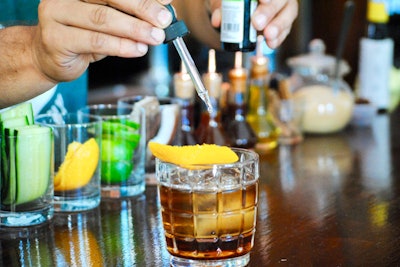According to industry experts and pros, the new year will see a continuation of current trends like sustainability and special dietary options, as well as bring about the return of bread and a rise in fermentation and CBD cocktails. Here’s more on the food forecast for 2019:
Food Waste & Sustainability Remain Important Issues
“We will continue to see the market focus, but to a greater degree, on sustainability and preservation. Culinarians will dig deeper into finding new and creative ways to expose guests to techniques such as fermentation, micro-farming, and the use of offal cuts. The thought of using everything and wasting nothing is becoming more and more ingrained into our culture and it is my belief that this is what will shine in 2019.” —John Herdman, executive chef, AT&T Hotel and Conference Center, Austin
“In light of the culinary industry becoming more conscious of food waste, the reduction of waste will become a norm in restaurants and at home. According to the James Beard Foundation, 40 percent of the food produced in the U.S. goes to waste. At an average of $1,500 per household per year, out of the 78.6 million U.S. homes, that’s more than $117 billion in waste. With proper education and recipes utilizing as much of an ingredient as possible, there is no reason why this should be a statistic.” —Jeff Osaka, chef and owner, 12 at Madison and Sushi-Rama, Denver
“In 2019, [Flagship Restaurant Group] will continue to focus on sustainability and animal welfare. Plant-based foods have been a common trend in the past, and we anticipate seeing this continue to thrive in the years to come. In addition to the trending paper straw movement, we’ve started implementing new practices in all of our concepts that raise the bar in regards to responsible operations.“ —Anthony Hitchcock, C.O.O. and owner, Flagship Restaurant Group, Omaha, Nebraska
“I think standard buffets are losing traction because people don’t want to wait in line. Plus, there is a sense that the food is not necessarily as fresh as it should be because it’s been in chafing dishes and there’s this sense of possible food waste that comes up.” —Andrew Freeman, founder, af&co., San Francisco
According to Kimpton Hotels & Restaurants’ fifth annual Culinary & Cocktails Trend Forecast, bartenders are embracing new approaches to sustainability including edible garnishes, on-site beehives, room-temperature cocktails, and bar and kitchen menus featuring fewer ingredients that are incorporated into multiple items.
Special Dietary Needs Are Still Top of Mind
“I believe we will see a continued push towards healthy cuisine and a large effort in meeting the dietary and allergy needs of masses. We will see an exciting drive to create new and better culinary products that cater towards the dairy/gluten-free consumer.” —Kyle Barham, chef de cuisine, the Carillon, Austin
“This is becoming more and more the norm, and I see this continuing in 2019 with meeting planners already asking what can we provide for their guests in terms of gluten-free options or buffets that fit a keto-style diet.” —Matt Horsley, director of food & beverage, Julie Diaz, director of catering and convention services, and Thad Crennen, executive chef, backYARD at Waller Creek, Austin
But… Bread Is Back!
“I think we’re realizing that with gluten allergies and sensitivities, there are other ingredients in our breads like preservatives that could be having an effect on diners with sensitivities. Especially here in the Southeast, I think we’ll see more and more restaurants trending toward breads made with heirloom/heritage grains and long-fermentation sourdoughs. Not only does this result in a more pure product, but it also produces a better flavor bread. As this trend continues, we’ll see bread making a comeback on menus in this new form." —Michael Perez, chef, Cannon Green, Charleston, South Carolina
San Francisco-based restaurant and hospitality consulting firm af&co. recently released its 2019 Hospitality Trend Report, which predicts that we’ll see “an appreciation for heritage grains and artisanal bread preparation.”
Ken Romaniszyn, owner of Lady M in Los Angeles, says that gluten will make a comeback, with pastry chefs focusing less on gluten-free offerings and more about high-quality flours and ingredients.
Lesser-Known Wines Will Pop Up on Drink Menus
“In the U.S., the focus seems to be shifting from consumers who believe that high quality must come with a high price tag to curious oenophiles who are looking for interesting wines from smaller producers and little-known wine-producing regions. As more people become interested in lesser-known varietals and lower manipulation wine production methods, I can see 2019 being a year of the educated wine consumer who is looking for more than just benchmark producers and cult classics, with a focus more on small wineries doing more natural viniculture and viticulture techniques in lesser known areas of the world.” —Susie Scott, beverage director and sommelier, the Carillon, Austin
“None of this is gonna break the budget. For instance, it would be really cool to introduce a Georgian wine or a South African wine [on a catering menu] versus the Mondavi.” —Freeman
Florals in Cocktails Continue to Bloom
“Florals are popping up everywhere. You can see this with new drinks served at our boutiques like Rose Tea Latte and London Fog [made with lavender buds]. We utilize florals in a way to emphasizes the delicate nature of the flavors, keeping it subtle and polished.” —Romaniszyn
Educational Experiences Still Keep Guests Entertained
“For 2019, it’s all about elevated entertainment experiences, specifically interactive and customizable opportunities to discover and explore new cultural and culinary traditions. At Sunda [in Chicago and Nashville], we have seen a huge demand in specialized interactive experiences like sushi-rolling classes and Japanese whiskey tastings. Guests enjoy a hands-on learning experience and discover a new skill. These events satisfy an untapped curiosity and hunger for self-discovery that they can share with others in the future.” —Billy Dec, founder and C.E.O., Rockit Ranch Productions, Chicago
“As diners become more aware of food and want to know more about where we’re sourcing ingredients and the techniques we’re using in the kitchen, education will become a key component of the dining experience. I think this will translate to fewer ingredients on the plate and cleaner presentations that allow ingredients to speak for themselves. It will also lend itself to more educational opportunities in the dining room. For example, our new tasting menu concept will provide guests with notecards describing the different ingredients and techniques used in the preparation of each course, offering an educational experience that allows the guest to learn without feeling intimidated by the menu or presentation.” —Perez
Fermentation Is Bubbling Up
"This technique will be more popular and mainstream than ever with the release of the Noma Guide to Fermentation book. I’m looking forward to making miso from fermented local soy beans, which is a six-month process, and experimenting with fermenting einkorn wheat and fruit.” —Seadon Shouse, chef, Halifax, Hoboken, New Jersey
T.J. Girard, creative director and owner of Pinch Food Design in New York, agrees, saying that “sour” will be the new trendy flavor with a rise in vinegar-based recipes, marinades, and sauces such as verjus and wine reductions and fermentation.
Plus, expect to see more gut-friendly, fermented, and probiotic-rich ingredients like tapache and sauerkraut infiltrating both dishes and drinks, according to Kimpton Hotels & Restaurants’ trend forecast.
‘Trash Fish’ Will Be Elevated
“Common fish is out. In the coming year, I think we’ll see that popular, omnipresent fish like salmon, tuna, swordfish, etc. will become less common on menus. More and more, I think we’ll see seafood preparations with ‘trash fish’—uncommon catches like triggerfish or sheepshead that are more sustainable. This is especially true here in Charleston.” —Perez
The Time Is High for CBD Cocktails
CBD tinctures will continue to take over cocktail menus, predicts af&co. Containing no THC [the active chemical in marijuana that gets you high], CBD delivers a dose of relaxation and sedation.




















